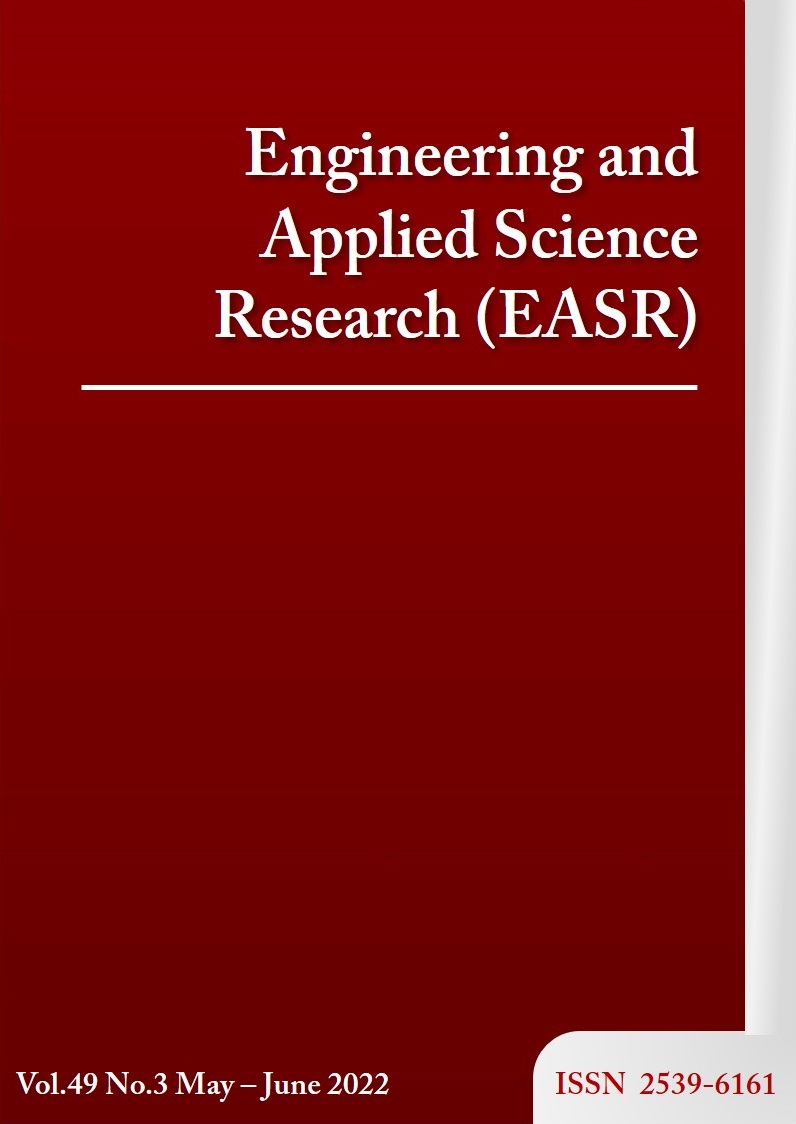Comparative study on path interval determinations in filleted end milling
Main Article Content
Abstract
This study provides several findings obtained from the comparisons of path interval determinations in filleted end milling with a tool inclination. CNC milling machine is one of the core technologies in practical manufacturing. Computer-aided technologies have contributed to the technological advancement. Tool path generation in computer-aided manufacturing is really important for CNC milling process. Although there are a lot of parameters treated in tool path generation, path interval is one of the influential factors in considering the balance between manufacturing efficiency and machined surface feature. A path interval determination in filleted end milling always includes the intersection problems with mathematical complexities in essence. To overcome the complexities, the related studies have been made so far. However, it is considerably difficult to search a study comparing the path interval determinations of filleted end milling, and this fact is making it difficult to select a suitable path interval determination in practice. Accordingly, this study focused on comparing four possible procedures of the path interval determinations. After the comparative discussions were made using the results using the four possible procedures, the several findings were revealed according to the explicit evidences.
Article Details
This work is licensed under a Creative Commons Attribution-NonCommercial-NoDerivatives 4.0 International License.
References
Liu M, Fang S, Dong H, Xu C. Review of digital twin about concepts, technologies, and industrial applications. J Manuf Syst. 2020;58:346-61.
Phanden RK, Sharma P, Dubey A. A review on simulation in digital twin for aerospace, manufacturing and robotics. Mater Today Proc. 2021;38(9):174-8.
Cimino C, Negri E, Fumagalli L. Review of digital twin applications in manufacturing. Comput Ind. 2019;113:103130.
Jones D, Snider C, Nassehi A, Yon J, Hicks B. Characterising the digital twin: a systematic literature review. CIRP J Manuf Sci Tech. 2020;29:36-52.
Lu Y, Liu C, Wang KI, Huang H, Xu X. Digital twin-driven smart manufacturing: connotation, reference model, applications and research issues. Robot Comput Integr Manuf. 2020;61:101837.
Oztemel E, Gursev S. Literature review of Industry 4.0 and related technologies. J Intell Manuf. 2020;31:127-82.
Alcacer V, Cruz-Machado V. Scanning the Industry 4.0: a literature review on technologies for manufacturing systems. Eng Sci Tech Int J. 2019;22(3):899-919.
Liu C, Xu X. Cyber-physical machine tool-the era of machine tool 4.0. Procedia CIRP. 2017;63:70-5.
Jędrzejewski J. Machine tool development from high level of holistic improvement to intelligence. J Achiev Mater Manuf Eng. 2015;73:55-64.
Neugebauer R, Denkena B, Wegener K. Mechatronic systems for machine tools. CIRP Ann Manuf Tech. 2007;56(2):657-86.
Fujishima M, Mori M, Nishimura K, Ohno K. Study on quality improvement of machine tools. Procedia CIRP. 2017;59:156-9.
Alghazzawi TF. Advancements in CAD/CAM technology: options for practical implementation. J Prosthodont Res. 2016;60(2):72-84.
Lasemi A, Xue D, Gu P. Recent development in CNC machining of freeform surfaces: a state-of-the-art review. Comput Aided Des. 2010;42(7):641-54.
Konobrytskyi D, Hossain MM, Tucker TM, Tarbutton JA, Kurfess TR. 5-Axis tool path planning based on highly parallel discrete volumetric geometry representation: part I contact point generation. Comput Aided Des Appl. 2018;15(1):76-89.
Bo P, Barton M, Plakhotnik D, Pottmann H. Towards efficient 5-axis flank CNC machining of free-form surfaces via fitting envelopes of surfaces of revolution. Comput Aided Des. 2016;79:1-11.
Harik RF, Gong H, Bernard A. 5-axis flank milling: a state-of-the-art review. Comput Aided Des. 2013;45(3):796-808.
Sekine T, Obikawa T. Normal-unit-vector-based tool path generation using a modified local interpolation for ball-end milling. J Adv Mech Des Syst Manuf. 2010;4(7):1246-60.
Layegh E, Lazoglu I. 3D surface topography analysis in 5-axis ball-end milling. CIRP Ann. 2017;66:133-6.
Choi YK, Banerjee A, Lee JW. Tool path generation for free form surfaces using Bezier curves/surfaces. Comput Ind Eng. 2007;52(4):486-501.
Obikawa T, Sekine T. A higher-order formula of path interval for tool-path generation. Int J Autom Tech. 2011;5:663-8.
Tunc LT. Smart tool path generation for 5-axis ball-end milling of sculptured surfaces using process models. Robot Comput Integr Manuf. 2019;56:212-21.
Huang Y, Oliver JH. Non-constant parameter NC tool path generation on sculptured surfaces. Int J Adv Manuf Tech. 1994;9:281-90.
Mladenovic GM, Tanovic LM, Ehmann KF. Tool path generation for milling of free form surfaces with feedrate scheduling. FME Trans. 2015;43(1):9-15.
Chen T, Shi Z. A tool path generation strategy for three-axis ball-end milling of free-form surfaces. J Mater Process Tech. 2008;208(1):259-63.
Sarma R. Flat-Ended tool swept sections for five-axis NC machining of sculptured surfaces. J Manuf Sci Eng. 2000;122(1):158-65.
Plakhotnik D, Lauwers B. Computing of the actual shape of removed material for five-axis flat-end milling. Comput Aided Des. 2012;44(11):1103-14.
Sekine T, Obikawa T. Novel path interval determination in 5-axis flat end milling. Appl Math Model. 2015;39(12):3459-80.
Sekine T, Obikawa T, Hoshino M. Establishing a novel model for 5-axis milling with filleted end mill. J Adv Mech Des Syst Manuf. 2012;6:296-309.
Lin Z, Fu J, Shen H, Gan W. A generic uniform scallop tool path generation method for five-axis machining of freeform surface. Comput Aided Des. 2014;56:120-32.
Tournier C, Duc E. Iso-scallop tool path generation in 5-axis milling. Int J Adv Manuf Tech. 2005;25(9):867-75.
Sekine T. A 3D geometrical consideration of path interval in filleted end milling. J Jpn Soc Abras Tech. 2016;60:515-9.
Sekine T. A computational algorithm for path interval determination in multi-axis filleted end milling. Adv Sci Tech Res J. 2020;14:198-205.
Sekine T, Kameya K. Remarkable characteristics of a novel path interval determination in filleted end milling. Journal Européen des Systèmes Automatisés. 2021;54(3):461-8.
Redonnet JM, Djebali S, Segonds S, Senatore J, Rubio W. Study of the effective cutter radius for end milling of free-form surfaces using a torus milling cutter. Comput Aided Des. 2013;45(6):951-62.
Segonds S, Seitier P, Bordreuil C, Bugarin F, Rubio W, Redonnet JM. An analytical model taking feed rate effect into consideration for scallop height calculation in milling with torus-end cutter. J Intell Manuf. 2019;30(5):1881-93.
Bedi S, Ismail F, Mahjoob MJ, Chen Y. Toroidal versus ball nose and flat bottom end mills. Int J Adv Manuf Tech. 1997;13:326-32.



